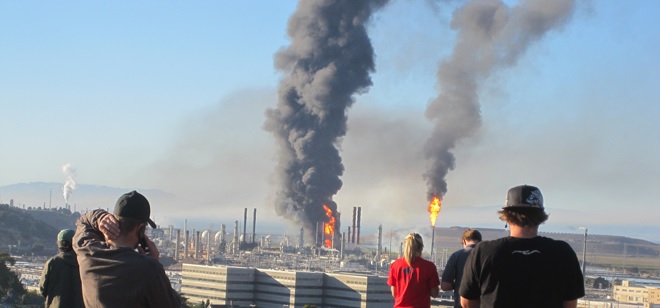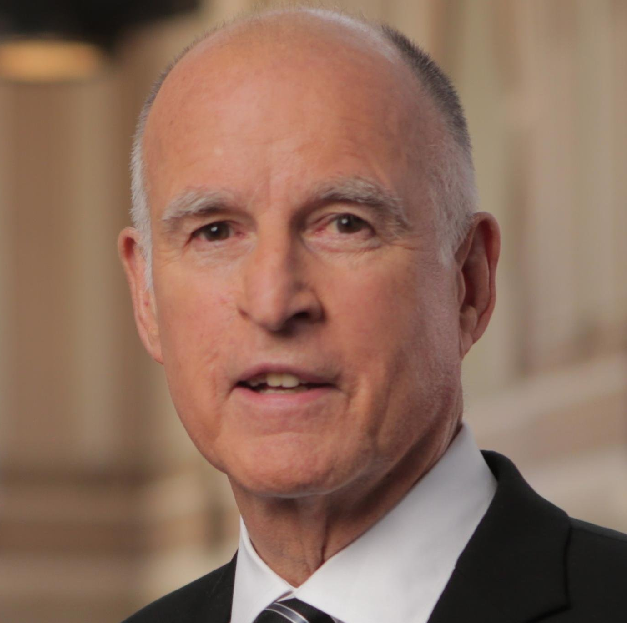
Here are some of the things that have happened in the past two days:
A giant piece of ice, the size of Delaware, broke off Antarctica, signaling even faster climate change and sea-level rise.
A report from the Union of Concerned Scientists showed how much of the Bay Area (and other coastal regions) will be suffering from constant, debilitating flooding in the very close future.

Gov. Jerry Brown announced that he would lead climate talks and put California in the lead after Donald Trump backed away from the Paris Accords.
And then Brown showed up at a state Senate committee to push a bill that makes the fossil fuel industry happy and will set back efforts at a renewable-energy future.
That’s right: This morning, the governor appeared at the Senate Environmental Quality Committee, which by a 5-2 vote passed a bill supported by PG&E, Southern California Edison, the California Manufacturers and Technology Association and most of the rest of the fossil-fuel industry.
Oh, and it’s also supported by the Natural Resources Defense Council and the Environmental Defense Fund, which all too often wind up in bad compromises with the utilities and industry, and Tom Steyer’s NexGen.
Opposed are the Sierra Club, Communities for a Better Environment, Food and Water Watch … that is, the environmental groups with a real grassroots base that see this as a terrible setback to climate-change initiatives.
“The science says we have to get off fossil fuels,” Adam Scow, director of Food & Water Watch California, told me. “This bill is largely a concession to the gas industry.”
Brown has made it very clear (as he has in the past) that this bill is a compromise. He’s repeatedly said he isn’t going to push “harsh measures” against the fossil fuel industries.
Instead, his “cap and trade” bill would allow fossil fuel companies to continue dumping carbon into the air until 2030 (at which point San Francisco and Oakland Airports could be flooded, as will much of Alameda Island and a lot of other places).
The idea, which Brown has pushed for years, is to use market systems to control emissions. The state sets a limit on how much carbon can be emitted, then companies buy and sell the right to blow it out their smokestacks.
This bill sets a price cap on how much companies can be forced to pay for polluting. And critically, it doesn’t allow local agencies, like the Bay Area Air Quality Management District, to set tighter limits on air pollution.
The district is opposing the bill.
The state’s “cap” – the amount of carbon that can be emitted – declines slightly every year. The law also allows “offsets” – that is, a polluter can buy the right to dump foul compounds into the air in California if the company does something somewhere else, like planting trees in another part of the country.
So a refinery in Richmond can sicken the people in that area, and “pay” for it by purchasing an offset.
The whole thing makes sense only if you believe that the private market, which created the problems we are facing, is the best solution to solving them. The other alternative – a plan to phase out all fossil-fuel emissions by 2030 – isn’t in the playbook of the governor who is making international headlines talking about climate change.
The bill is on the fast track, and is slated to be heard by both houses of the Legislature Monday/17. It needs a two-thirds vote, so if progressives and environmentalists can round up 14 votes in the Senate or 27 in the Assembly it will have to be recrafted.
The deep issue here is how California, which is seen as an environmental bellwether, is going to address the increasingly urgent issue of climate change. And in this case, the governor is pushing a bill that lacks any real sense of urgency.
The bill, Scow told me, “makes a mockery of Brown’s climate leadership.”
I have reached out to Assemblymembers David Chiu and Phil Ting and to Senator Scott Wiener for their positions on the bill, but have not heard back.



I do not live or want to live in a submarine – yellow – or otherwise.
CO2 plus H2O – ie, the ocean, causes a donation of a hydrogen atom to the water, which means a higher ocean pH, causing ocean acidification, which kills the coral reefs and decimates shellfish. Not good.
…gee what a surprise…anybody expecting the democrats to do ANYTHING…about ANYTHING…simply has NOT been paying attention …they are in the pocket…of whatever industry they are supposed to be monitoring …american exceptionalism.
According to Jerry, without this tax we will have mass migration, forest fires, floods, disease and other pestilence. The very existence of humanity rests on extending Brown’s cap and tax law.
CO2 is your mother’s breath. Without CO2 there would be no life on earth as we know it.
The CO2 (380 ppm) in the ambient air is far from dangerous. In Navy submarines, they allow it up to 8,000 ppm with few adverse effects. The average concentration in nuclear-powered ballistic missile submarines is 3,500 ppm ranging up to 10,000 ppm. Federal guidelines set a maximum occupational exposure limit at 5,000 ppm as a time-weighted average for an eight-hour workday.
However, there are studies, that have not been replicated with larger samples, that high CO2 levels in office buildings can impair performance. This may be an argument for not making office building too energy efficient.
Appreciate the data that supports some of what you wrote. However, CO2 does make people sick.
Regardless, reducing all types of pollution is beneficial.
The calving of the Larsen C ice shelf is a natural occurring event. The scientist said it indicates the health of the shelf. Since it was already afloat, it will have no influence on sea levels.
http://www.smh.com.au/nsw/experts-says-calving-of-larsen-c-ice-shelf-could-be-a-positive-sign-20170713-gxam35.html
There has been no Bay Rise in 30 years. At the current rate, based on the past 100 years, it will take 500 years to see the rise in the 2100 map.
https://tidesandcurrents.noaa.gov/sltrends/sltrends_station.shtml?stnid=9414290
CO2 won’t make anyone sick.
I called the offices of Chiu and Wiener on July 13 to encourage a no-vote. Wiener’s staffer said, “Oh, right, Scott has some concerns about this.”
Brown is being especially hypocritical given his recent pushback against Trump.